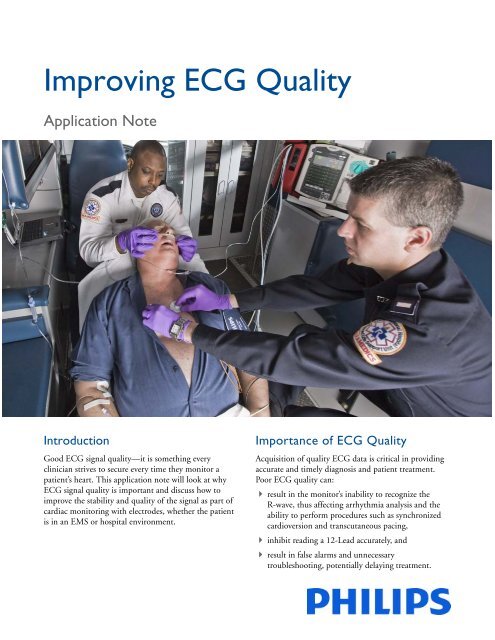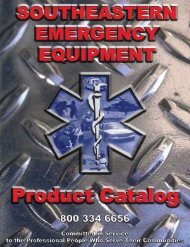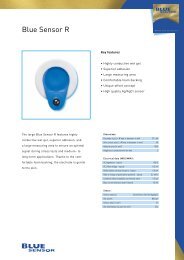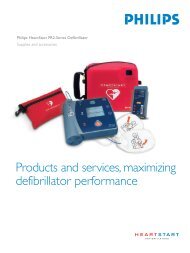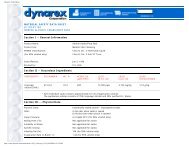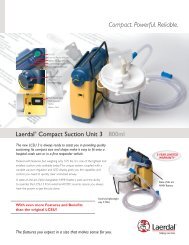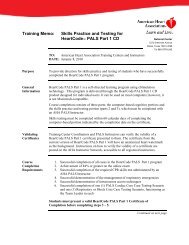Improving ECG Quality - InCenter - Philips
Improving ECG Quality - InCenter - Philips
Improving ECG Quality - InCenter - Philips
You also want an ePaper? Increase the reach of your titles
YUMPU automatically turns print PDFs into web optimized ePapers that Google loves.
<strong>Improving</strong> <strong>ECG</strong> <strong>Quality</strong>Figure 23-Lead Electrode PlacementFigure 410-Lead Electrode PlacementRALALLFigure 35-Lead Electrode PlacementRAILAIIaVRVaVFaVLIIIElectrode-to-Patient ContactPoor electrode-to-patient contact can result in poor signalquality and relative waveforms, as well as false alarms.Poor contact could result from to poor skin preparation,dried electrode gel, and/or defective <strong>ECG</strong> cables or leadwires. 1 Keep in mind the following guidelines to ensuregood contact:RLLL Once attached, electrodes should not move in anyway. Check electrodes periodically for firm adhesion andcomplete contact. If an electrode moves easily, theelectrode connection is too loose and may need to bechanged. Tape down the lead wire about 3-4 inches away fromthe electrode, with slack in the wire to prevent it frompulling on the electrode.4PUBLISH
<strong>ECG</strong> <strong>Quality</strong> ImprovementArtifact EliminationAn artifactual signal is anything on an <strong>ECG</strong> that is notcaused by the electrical currents generated by the heart. 2This signal can come from sources such as: electrical interference (also known as low frequencynoise) originating from the 60Hz current whichsupplies power to electrical wall outlets, or from aremote device such as a cell phone, muscle tremor, patient movement, or loss of electrode contact. 8It is difficult to deal with electrical interference since itcan’t be filtered without compromising the <strong>ECG</strong>complex because of its similarity to the <strong>ECG</strong> signalfrequency, so it is best to monitor away from otherequipment, ensuring cable and lead wires do not crossthe power cables of other equipment or vent tubing. Toreduce muscle tremor and patient movement, attempt towarm a shivering patient or make them morecomfortable in a reclined position, if possible, rather thanadjust a filter setting. 2 Finally, continually check leadwire-to-electrode connection and electrode-to-patient’sskin adhesion to ensure <strong>ECG</strong> quality and prevent falsealarms, as mentioned in the previous section.Lead SelectionIt is important to select a suitable lead that shows thelargest amplitude and cleanest signal so that a QRScomplex and R-wave, in particular, can be accuratelydetected by the monitor. Consider the following leadselection guidelines: The QRS complex should be tall and narrow(recommended amplitude > 0.5 mV). The R-wave should be above or below the baseline(but not biphasic). The P-wave should be smaller than (1/5) R-waveheight. The T-wave should be smaller than (1/3) R-waveheight.To prevent detection of P-waves or baseline noises asQRS complexes, the minimum detection level for QRScomplexes is set at 0.15 mV, according to AAMI-EC 13specifications. If the <strong>ECG</strong> signal is too weak, you may getfalse alarms for asystole.In many monitors, increasing the gain (size) of the <strong>ECG</strong>does not change the signal to the monitor. Therefore, thesignal should meet the above criteria without changingthe gain to ensure the monitor can accurately analyze thewaveform.PUBLISH5
<strong>Improving</strong> <strong>ECG</strong> <strong>Quality</strong>ConclusionClinicians depend on the monitors they use every day toprovide accurate and useful information. When it comesto <strong>ECG</strong> quality, the electrode type, electrode application,and skin preparation are factors that play an importantrole in sending a good <strong>ECG</strong> signal to the monitor foranalysis. The goal is to eliminate as much resistance,interference, and/or artifact as possible to ensure stableelectrophysiologic recordings for better analysis,diagnosis, and treatment of the patient’s condition. Theresults should be a reduction in: troubleshooting <strong>ECG</strong> quality, time delay to patient care, and frustration on the part of the clinician.References1 Smith, M. “Rx for <strong>ECG</strong> monitoring artifact.” Critical CareNurse, 1984: 4: 64-66.2 Odma, S., Oberg, P. “Movement-induced potentials insurface electrodes.” Medical Engineering and Computing,1982: 20: 159-166.3 Adams-Hamoda, M., Caldwell, M., et al. “Factors toconsider when analyzing 12-lead electrocardiograms forevidence of acute myocardial ischemia.” American JournalCrit Care, 2003: 12: 9-18.4 Gray, Henry. Anatomy of the Human Body, 20th ed.Philadelphia: Lea & Febiger, 1918.5 Medina, V., Clochesy, J.M., Omery, A. “Comparison ofelectrode site preparation techniques.” Heart Lung: J CritCare, 1989: 18: 456-460.6 Oster, C.D. “<strong>Improving</strong> <strong>ECG</strong> trace quality.” BiomedicalInstrumentation & Technology, 2000: 34: 219-222.7 Millar, S., Sampson, L.K., Soukup, S.M. AACN proceduremanual for critical care. Philadelphia: WB Saunders, 1985.8 Mirvis, D.M., Berson, A.S., Goldberg, A.L.“Instrumentation and practice standards forelectrocardiographic monitoring in special care units.”Circulation, 1989: 79: 464-471.<strong>Philips</strong> Healthcare is partof Royal <strong>Philips</strong> ElectronicsOn the webwww.philips.com/heartstartBy e-mailhealthcare@philips.comBy fax+31 40 27 64 887By postal service<strong>Philips</strong> Healthcare3000 Minuteman RoadAndover, MA 01810-1085AsiaTel: +852 2821 5888Europe, Middle East, and AfricaTel: +49 7031 463 2254Latin AmericaTel: +55 11 2125 0744North AmericaTel: +425 487 70001 800 285 5585 (USA only)© 2008Koninklijke <strong>Philips</strong> Electronics N.V.All rights are reserved.Reproduction in whole or in partis prohibited without the priorwritten consent of the copyrightholder.<strong>Philips</strong> Healthcare reserves the rightto make changes in specifications orto discontinue any product at anytime without notice or obligationand will not be liable for anyconsequences resulting from the useof this publication.Published Sept. 2008, Edition 1Printed in the USA453564119681*453564119681**1*6PUBLISH


